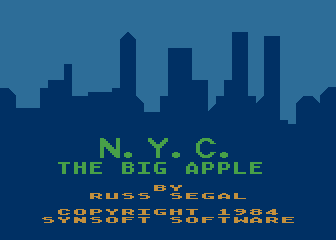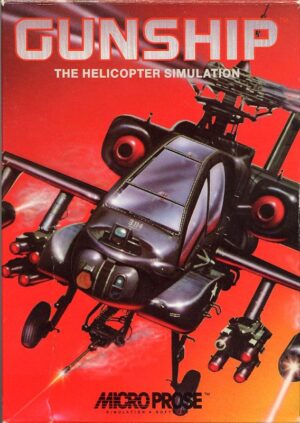Retro Replay Review
Gameplay
New York City places you behind the wheel of Ed Hick’s red atomic Plymouth Continental, thrusting you headlong into the frenetic rhythm of urban navigation. From the outset, you’ll grapple with two distinct vehicle types: the harmless cruising cars that you can steamroll without consequence, and the menacing tow trucks that threaten to dismantle your ride at the slightest collision. Balancing aggression and caution becomes a constant trial as you weave through city streets, mindful of both your gas gauge and potential dents in your fender.
The strategic depth heightens when you realize that running out of gas or sustaining too much damage won’t just leave you stranded—it lands you in the hospital and your car in the impound, costing you a hefty $100 repair fee. This penalty system injects a sense of risk versus reward into every maneuver, forcing you to weigh each high-speed dash against the mounting potential for financial loss. And should your wallet hit zero, the game ends, making every dollar you spend a precious commodity.
Adding another layer of challenge is the bank forays, where you can replenish your funds but must navigate a gauntlet of bank robbers firing relentlessly. Reaching the teller safely earns you $500, a tempting windfall that keeps the tension high. This cat-and-mouse mini-sequence provides a satisfying diversion from street traffic, rewarding bold runs with much-needed cash while heightening the city’s sense of unpredictability.
Graphics
Visually, New York City embraces a retro-inspired, top-down perspective that delivers clear, functional pixel art. The color palette leans into muted grays and browns for the streets, punctuated by vivid reds and blues to highlight your Plymouth and other interactive elements. While not pushing modern hardware, the game’s aesthetic captures the gritty, bustling atmosphere of a metropolis, with blinking traffic lights, neon storefront signs, and animated pedestrian crosswalks.
Environmental details, such as meter maids patrolling parking zones and tow trucks screeching to a halt when you outstay your welcome, add depth to the cityscape. Each district has its own visual flair—downtown’s skyscrapers gleam in the distance, while suburban avenues feel quieter, with tree-lined sidewalks and smaller shops. Though minimalist, the graphics serve the gameplay well, ensuring that every important element—from meter timers to enemy vehicles—is instantly recognizable.
Transitions between driving and on-foot exploration are handled smoothly, with the camera zooming out to give you a better view of the city when behind the wheel, then focusing tightly on Ed as he navigates building interiors. While some might find the retro style simplistic, it’s a conscious design choice that prioritizes clarity and playability over flashy effects. The result is a cohesive visual package that feels both nostalgic and effective for the game’s objectives.
Story
At its core, New York City offers a straightforward narrative: Ed Hick’s impulsive day trip becomes a high-stakes trial of resourcefulness and timing. There’s no deep character arc or sprawling lore—just a relatable protagonist who must adapt quickly to the chaos of the big city. The simplicity of Ed’s motivation—a desire to see famous landmarks before nightfall—grounds the experience and keeps the focus on gameplay challenges.
Despite its minimalist plot, the game sprinkles in small touches of humor and personality. Traffic reports on your in-game radio mention quirky incidents, and tow truck drivers occasionally taunt you over the PA system, adding levity to stressful moments. The bank robber sequences feel cinematic, transforming a routine deposit into a pulse-pounding rescue mission that underscores the unpredictable nature of urban life.
Individual building excursions introduce brief narrative snippets, too. Each mini-game is framed as an exploration of a famous site—be it a museum, a theater, or a rooftop garden—with small cutscenes or text captions that provide context. While these sequences are concise, they flesh out the city’s character, making each landmark feel more than just an objective on your status bar.
Overall Experience
New York City strikes a compelling balance between arcade-style action and strategic resource management. The constant tension of time, money, and vehicle integrity keeps you engaged throughout the day-long run, while bank heists and brief on-foot challenges inject fresh variety. Though the core mechanics are straightforward, the layered threats and mini-game stops create a surprisingly deep and replayable experience.
The game’s retro graphical style and minimalist story may not appeal to those seeking cinematic epicness, but they work in concert to highlight the gameplay’s precision and pacing. Every dollar earned, every parking meter vigilantly monitored, and every tow truck narrowly avoided contributes to a cohesive sense of immersion in Ed Hick’s whirlwind city adventure.
For players who relish quick-thinking, high-stakes scenarios and enjoy retro aesthetics, New York City delivers a uniquely challenging day in the life of an ambitious sightseer. Its blend of driving, shooting, and mini-game exploration makes for an engaging ride—and one that invites multiple attempts to perfect your route, maximize your earnings, and conquer the urban jungle before nightfall.
 Retro Replay Retro Replay gaming reviews, news, emulation, geek stuff and more!
Retro Replay Retro Replay gaming reviews, news, emulation, geek stuff and more!









Reviews
There are no reviews yet.